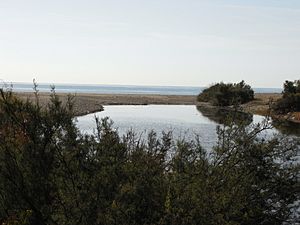Guadalmina facts for kids
Quick facts for kids Rio Guadalmina |
|
|---|---|

Mouth of the Guadalmina River between Marbella and Estepona
|
|
| Country | Spain |
| Physical characteristics | |
| Main source | Igualeja, Sierra Bermeja, Spain |
| River mouth | Mediterranean Sea, Málaga, Spain 0 m (0 ft) 36°27′36″N 5°0′19″W / 36.46000°N 5.00528°W |
| Length | 28 km (17 mi) |
The Guadalmina River is a short river located in southern Spain. It flows entirely within the Málaga province in the region of Andalusia. Its name comes from Arabic, meaning "river of the port."
Contents
Where the Guadalmina River Flows
The Guadalmina River is about 28 kilometers (17 miles) long. It begins in the Sierra Bermeja mountains, near a town called Igualeja.
However, its main journey really starts lower down, in the area of Benahavís. Here, the river creates a special underground water system called a karst aquifer. This happens in a place known as Las Angosturas, which means 'the narrows'.
The river then flows into the area of Marbella, close to San Pedro de Alcántara. It even helps mark the boundary between Marbella and the nearby town of Estepona.
How the River Helps People
The Guadalmina River was once very important for the people of Marbella. It helped protect the area from invaders. Its waters also powered watermills, which were used to grind grain into flour.
Today, the river plays a key role in providing water for many towns. The La Concepción reservoir collects water from several rivers, including the Guadalmina. This water is then sent to supply towns along the Costa del Sol. These towns include Benalmadena, Fuengirola, Mijas, Benahavís, Marbella, Casares, and Manilva.
The lower part of the river, near its mouth, has many homes built close to it. Because of this, some of these homes are at risk of flooding when the river rises.
Ancient History Along the River
Near where the Guadalmina River meets the sea, close to San Pedro de Alcántara, you can find important historical sites.
One site is the Basílica de Vega del Mar. This was an early Christian church built in the 4th century. Another site is Las Bóvedas (the Domes), which are Roman baths from the 3rd century. There is also a watchtower called Torre de Las Bóvedas nearby. These sites show how people have lived and used this area for a very long time.
See also
 In Spanish: Guadalmina para niños
In Spanish: Guadalmina para niños


